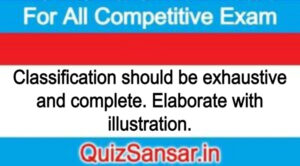
Classification should be exhaustive and complete. Elaborate with illustration.
Classification should be exhaustive and complete. Elaborate with illustration.
Ans.
Meaning
In the words of Connor, “Classification is the process of arranging things (either actually or notionally) in groups or classes according to their resemblances and affinities and gives expression to the unity of attributes that may subsist amongst a diversity of individuals.” According to this definition, the main features of classification are as follows:
(i) Under classification, collected data are grouped in different classes. For example, according ages, the persons can be divided into the groups of, 0-9 years, 10-19 years, 20-29 years, 30-39 years etc. On the basis of literacy, they can be dividend into two groups viz; Literate and Illiterate.
(ii) The data are classified on the basis of similarities and homogenity or in other words the data having one type of attribute are grouped in one class.
(iii) Classification is completed either on actual basis or on notional basis. The classes are determined on the basis of natural attributes or at the sweet will of statistician on notional basis.
(iv) Classification is made in such a manner that diversity of units is made clear in unity.
Elements of an Ideal Classification
A good classification should possess the following characteristics:
(i) Comprehensiveness- The classification must be so exhaustive in the sense that each and every item of the data is covered in one group or the other. No unit must be left. If some of the units are included in any one of the groups, then a residual class like ‘others’ or ‘miscellaneous’ be provided. If only two groups are made for marital status i.e. ‘Married’ and ‘Unmarried’ then the ‘widows’, ‘widowers’ and diversed ones shall remain excluded. As such classification shall be incomplete. Thus, while making classification, it should be kept in mind that it is complete and comprehensive.
(ii) Unambiguous and Well Defined- Different class groups should be so determined that they are rigid, clear and well defined. There should not be any doubt or confusion regarding the placement of observations in the given classes. Each unit must be included in one group only.
(iii) Stability- Stability is a vital factor for an ideal classification. If classes are changed in each meaningful. For example, the basis of professional persons in census of population in India is different in different censuses, as such the population data are not comparable.
(iv) Confirmity- Classification should be in confirmity with the object of investigation. For example if we want to study economic conditions of the workers. Classification according to their age groups or marital status shall be useless. In such a case, classes should be formed according to their income.
(v) Homogeneity- In classification every unit of homogeneous quality should be placed in one class so as to draw correct conclusions.
(vi) Flexibility- Classification must have the capacity of adjustment to new situations. It means the class groups may be increased or decreased according to changing circumstances.






